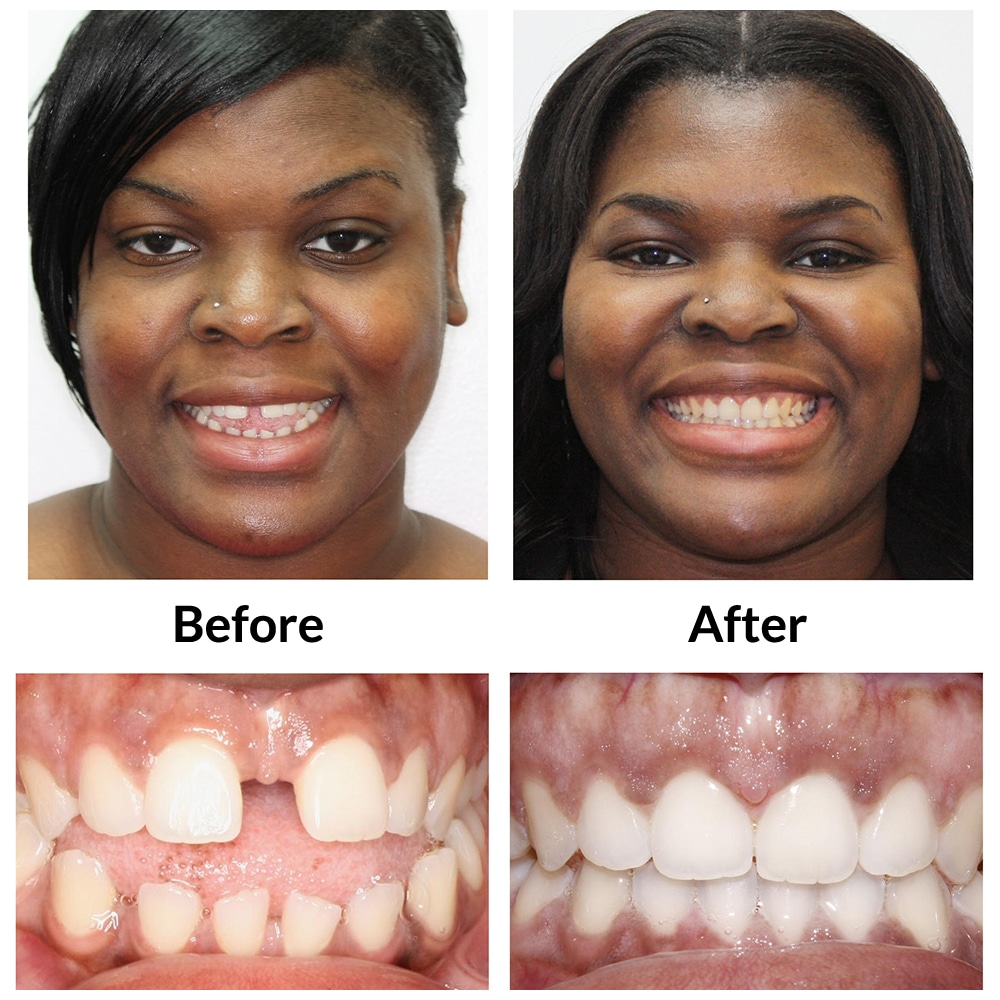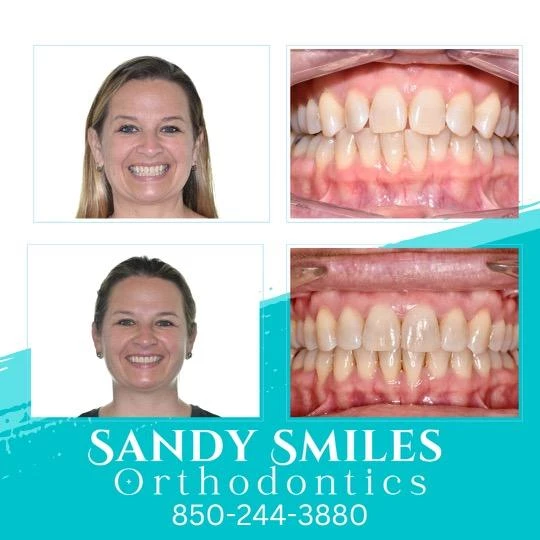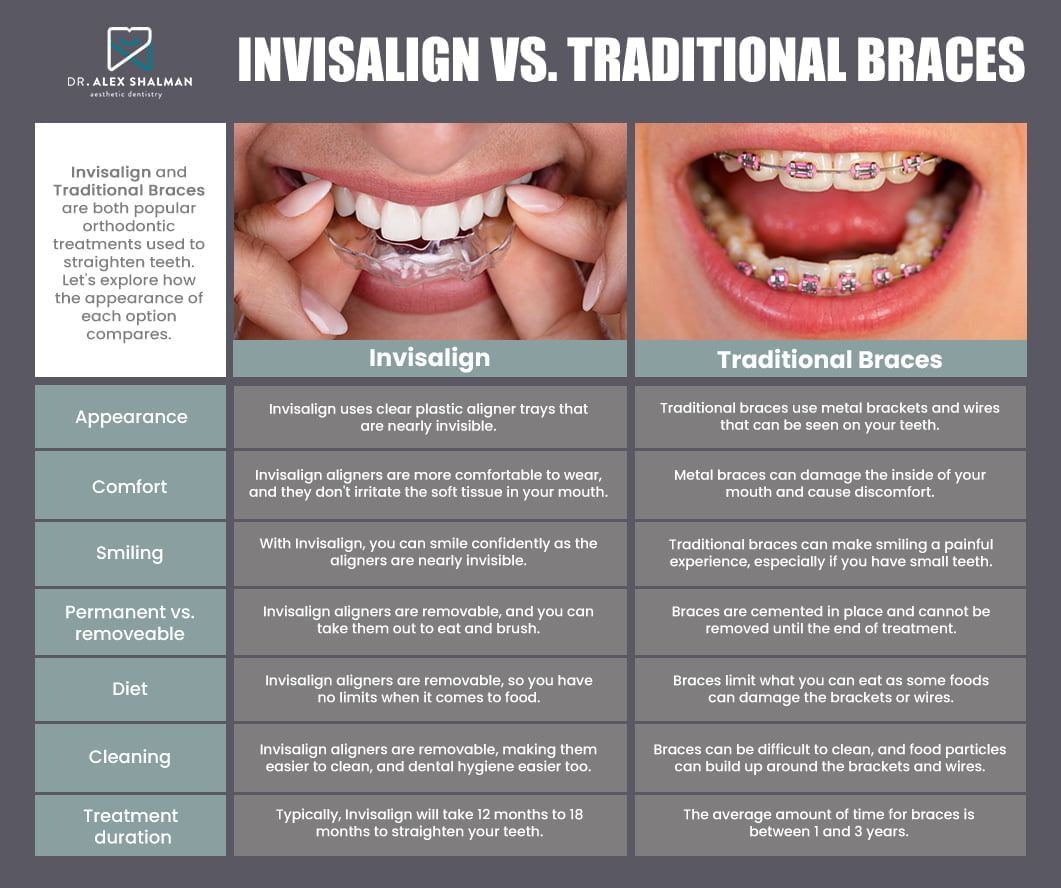Success Stories: How Invisalign Changed Lives and Enhanced Confidence
Success Stories: How Invisalign Changed Lives and Enhanced Confidence
Blog Article
Invisalign vs. Standard Braces: Which Option Is Right for You?
When taking into consideration orthodontic treatment, the selection between Invisalign and traditional dental braces offers several crucial elements that merit careful analysis. Invisalign provides a discreet choice with detachable aligners, while standard dental braces supply a much more noticeable yet effective remedy for extreme imbalance. Each choice includes unique benefits and downsides associated to visual appeals, comfort, therapy duration, and price. Understanding these nuances is essential for making an informed decision that lines up with your personal choices and lifestyle. The inquiry stays: which choice will finest satisfy your orthodontic requirements and assumptions?
Summary of Therapy Choices

In comparison, conventional dental braces include metal brackets and cables that are adhered to the teeth. This technique applies continual stress in time to attain placement. While effective for complicated orthodontic problems, standard braces call for regular sees for adjustments and can position difficulties in preserving dental health as a result of the trouble of cleaning around cables and brackets.
Both choices have their values, and the choice typically pivots on certain oral problems, way of life choices, and individual conformity. Eventually, getting in touch with an orthodontic professional is essential for figuring out the most suitable treatment plan customized to specific demands. Recognizing the subtleties of each alternative can dramatically affect the total success of orthodontic therapy.
Aesthetic Considerations
A significant variable influencing the selection in between Invisalign and conventional dental braces is the aesthetic charm each therapy supplies. Invisalign aligners are crafted from clear plastic, making them virtually invisible when worn.
In comparison, typical braces include steel braces and cables, which can be extra obvious. While innovations in orthodontic technology have actually brought about the growth of smaller braces and tinted elastics, conventional dental braces still preserve an even more conspicuous account. For some individuals, the presence of braces might hinder them from seeking needed treatment.
Eventually, the selection in between Invisalign and conventional dental braces might rest on personal choices regarding appearances. Clients that focus on discernment typically favor Invisalign, while those that are less concerned concerning visibility may choose traditional braces. Comprehending the visual effects of each option is vital for making an educated choice that straightens with one's lifestyle and preferences.
Convenience and Convenience

In regards to benefit, Invisalign aligners are removable, enabling people to appreciate their favored foods without restriction and maintain optimal dental hygiene. Cleaning and flossing are simplified, as the aligners can be taken out throughout these routines, whereas typical braces require mindful maneuvering around braces and cables.
In comparison, typical braces require normal adjustments, making them much less hassle-free for those with busy schedules. Generally, the comfort and comfort of Invisalign make it an enticing choice for lots of people seeking orthodontic therapy.
Treatment Duration and Performance
While both Invisalign and conventional dental braces are effective in fixing oral misalignments, the duration of therapy can differ considerably in between the 2 alternatives. Generally, Invisalign treatment can take anywhere from 12 to 18 months, depending upon the intricacy of the instance. The clear aligners function by progressively changing teeth right into their wanted positions, and regular follow-ups with an orthodontist help ensure progress stays on the right track.
In comparison, standard dental braces usually call for a longer dedication, normally varying from 18 months to 3 years. This is because of their fixed nature and the use of wires and brackets, which can be more effective for complicated situations and severe misalignments (Invisalign). The therapy performance of typical dental braces is well-documented, as they permit accurate adjustments and greater control over tooth activity
Inevitably, the option between Invisalign and traditional dental braces might rest on both the anticipated therapy duration and the particular oral concerns available. Consulting with an orthodontist is important, as they can give tailored recommendations based upon specific requirements, making sure the selected approach lines up with desired timeframes and end results.
Expense Comparison and Insurance Alternatives
Cost plays a substantial function in the decision-making process for people thinking about orthodontic treatment, whether choosing Invisalign or conventional braces. Typically, the price of Invisalign varieties from $3,000 to $8,000, while traditional dental braces usually cost in between $2,000 and $6,000. Elements affecting these expenses include the intricacy of the case, the period of therapy, and geographical location.
Insurance policy protection can considerably influence out-of-pocket costs. Numerous dental insurance policy strategies give partial protection for orthodontic therapies, however the specifics can differ commonly. It is essential for patients to examine their insurance coverage to determine the degree of insurance coverage for either option. Normally, conventional dental braces may be much more frequently covered by insurance policy plans contrasted to Invisalign, which some insurers classify look at here now as an aesthetic procedure.
Additionally, several orthodontic methods provide versatile repayment strategies, making both treatment alternatives a find more lot more obtainable. Patients should ask about potential funding alternatives and price cuts for ahead of time payments. Reviewing the overall cost, consisting of insurance policy advantages and layaway plan, is essential for making an informed choice that straightens with both visual choices and budget plan considerations.

Conclusion
In summary, the selection in between Invisalign and standard dental braces hinges on multiple factors, consisting of visual preferences, convenience, therapy duration, and cost. Invisalign offers a very discreet, detachable option that facilitates dental health and dietary flexibility, while typical dental braces may be extra ideal for complicated dental concerns and commonly come at a reduced cost point. Inevitably, examination with an orthodontist is important to assess specific scenarios and identify the most appropriate therapy option for attaining ideal dental positioning.
When thinking about orthodontic treatment, the option between Invisalign and standard braces provides a number of important variables that merit mindful assessment.Contrasting Invisalign and conventional dental braces reveals distinctive treatment options for orthodontic modification.While both Invisalign and traditional dental braces are efficient in fixing dental imbalances, the period of therapy can vary significantly in between the two choices.Cost plays a considerable role in the decision-making process for click people considering orthodontic treatment, whether choosing for Invisalign or typical braces.In summary, the option in between Invisalign and traditional braces hinges on numerous factors, including aesthetic choices, convenience, treatment duration, and expense.
Report this page